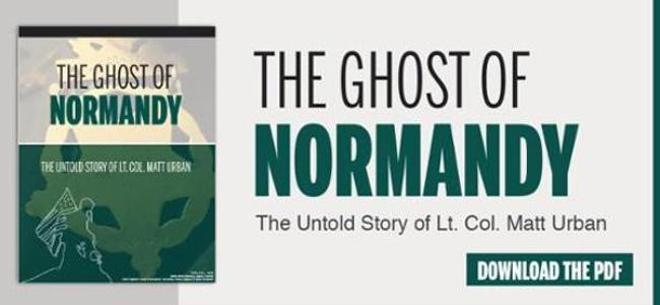What really happened to the famous American paratrooper who remained hanging from the steeple of the church of Sainte-Mère-Eglise on D-day?
Normandy American Heroes retraces the path taken by this colorful character: from Normandy back to the United States, where he passed away in 1969.
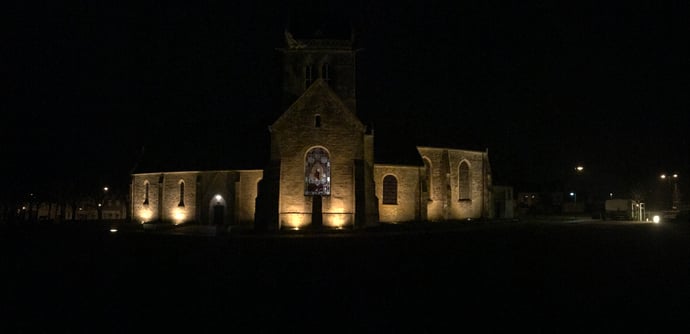
His name was Steele, John Steele, "John big ass", for his companions in arms! He came from Illinois, a jaw-dropping fellow who loved to drink fresh beer, practice fly fishing, and listen to New Orleans jazz. His letters to the Normans were full of warm words for this distant land he had first seen from the sky, one night in June 1944, and then trampled several times. In one of his letters, nicely signed "John of the Steeple”, he said how grateful he had been, and vowed to preserve his memory until his last breath.
An inn bears his name, “l’Auberge John Steele, 4 rue du Cap de Laine, 50480 Sainte-Mère-Église” just next door to the church “Notre Dame”.
Years have passed, forty-eight since his death, seventy three since D-day. The 1612 inhabitants of Sainte-Mère-Eglise (Manche) have not forgotten. John Steele (1912-1969) will remain forever the savior hanging on the roof of Notre-Dame-de-l'Assomption on the evening of the decisive offensive.
Let’s be realistic; it’s thanks to him and the iconic movie "The Longest Day" that visitors come each year to take a photo of the dummy hanging on the wrong side of the Sainte-Mère-Eglise steeple!
So who WAS John Steele? In the 1930s, the Steeles were a model family living in Metropolis, Illinois. His father, also named John, piloted freight boats on the brownish waters of Ohio. He was a born captain, a man of authority who transported cargoes of wood and/or coal while his wife, Josephine, took care of the traditional wooden house. The couple raised seven children, two girls and five boys. John Marvin, the future paratrooper, was the eldest of the siblings. He was a tough guy, a good American football player, more a Democrat than a Republican. In the family photos, he looks a bit like “Forrest Gump”, with a straight bust, and a high forehead. He wasn’t such a great student, and eventually dropped out of college; it was said he wanted to become a barber. But when the United States entered the war at the end of 1941, his fate was to change forever: while one of his brothers, James, opted for the navy and another, Norman, for the army, John joined the paratroopers at the ripe old age of 29.
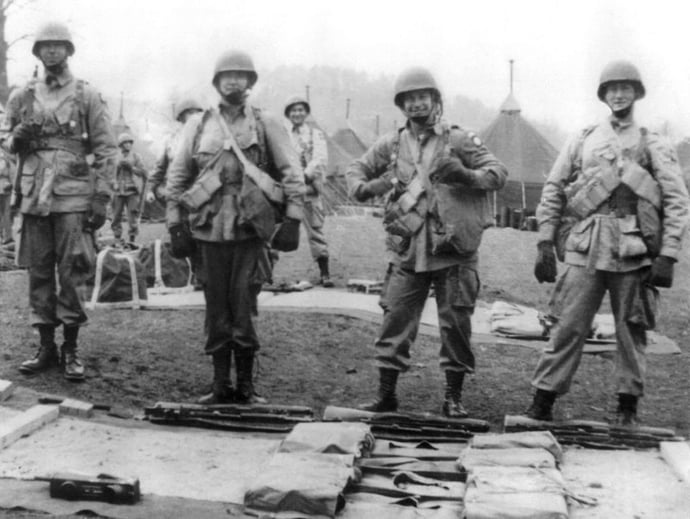
John Steele, second from the right
In the spring of 1943, John Marvin Steele discovered North Africa with the 82nd Airborne Division. Very soon, the missions followed one after the other, with a first battle jump on Sicily, during which he broke one leg, then a second on the Naples region, without injuries this time. Steele and his companions from company F then took the boat to the United Kingdom, where the Allied forces were preparing the landing on the French coasts of Normandy. The little guy from Metropolis first stayed in Northern Ireland, the land of his ancestors, and then trained near Leicester, England. In a letter to his family, he wrote that he played golf on days of permission and managed to earn a few dollars by cutting the hair of his comrades; and charging an extra cost to officers!
In the night of Monday the 5th of June 1944, Operation Overlord and Neptune are launched by the Supreme Allied Commander General Eisenhower who stated "Ok let's go" in the library of Southwick house, England (1)
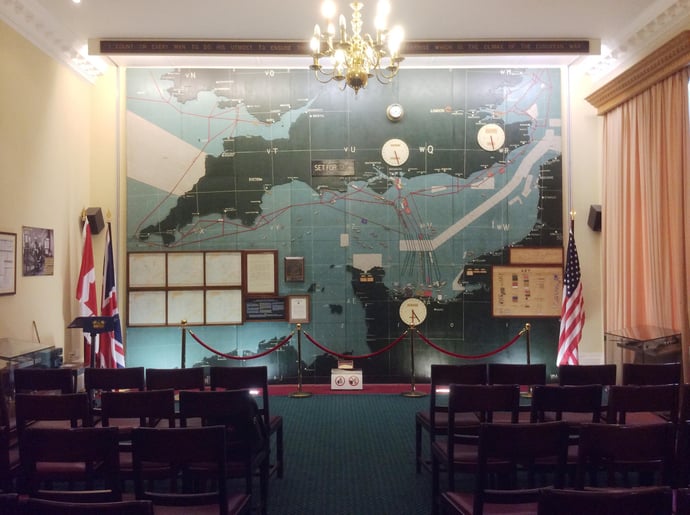
Southwick house, United Kingdom - Dday map
Approximately 15,000 paratroopers of the 82nd and 101st Airborne Divisions took off from England with identified drop zones away from the swamp area. Steele, like hundreds of others, discovered his mission: to jump on the outskirts of Sainte-Mère-Eglise and take control of it to facilitate the offensive planned at dawn on the coast, 10 kilometers away at Utah beach. In the wake of battle to come, he climbed aboard a C-47, with about fifteen guys harnessed in commando style, his face grimed in black. "Inside, everything was silent," he said, "some of us were drowsy; we knew we were going to a place where it would be a little hot."
To visualize what happened, one needs to be reminded that the majority of the Pathfinders who jumped before the Paratroopers to designate the drop area will not succeed. Worse, the weather conditions deteriorated. Each squadron leader was flying with lights on his wings BUT the rest of the formation flew visually, no lights! The pilot flying Steele stick was inexperienced. Fearing the anti-flak he climbed to high and ordered the paratroopers to jump right above Sainte-Mère-Eglise! When they jumped out they were right above the village, hell broke out loose everywhere, some paratroopers of the 101st division were dropped there by mistake, among them Lieutenant Winters…more than 10 kilometers from his objective, Sainte-Marie-du-Mont! Several members of company F were killed before reaching the ground. "Taken out like ducks", will testify a survivor.
John is wounded on the left foot, probably by a flesh-ripping jagged piece of steel, but continues his descent towards the central square where a barn is on fire. While trying to avoid the blaze, he crashed on the church, a beautiful building of the XII century. His parachute clings to one of the sculptures erected at the base of the bell tower and leaves him suspended at a dozen meters from the ground. He tries to cut himself loose, but his knife escapes his grip and falls along the wall. He is now more helpless than ever, a mere puppet at the mercy of enemy fire, forced to play dead, his eyes half opened, praying…
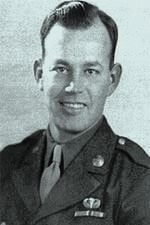
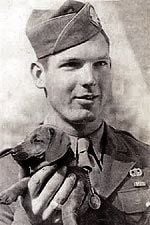
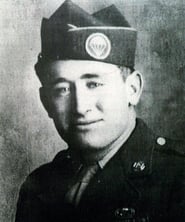
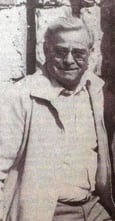
John Steele John Ray Ken Russell Rudolf May
The hours passed, soon three, still no support in sight. Finally, two Germans positioned in the bell tower, Rudolf May and Rudi Escher, spotted him. (2)
They cut down the lines of his parachute. Once on the ground, Steele was, along with six other Americans, taken prisoner and held in an enemy command post. He would not be mistreated or held back too long: four days later, he escaped by sneaking through a window. The German rout was such that he succeeded in making it back to the front line before being evacuated to the United Kingdom. Once he recovered from his foot injury, he took part in the unsuccessful Allied military operation known as Market Garden in the Netherlands before ending up in an American camp near Marseilles, France.
On his return to the country in September 1945, John, full of medals, spoke little of the war. Like his relatives, he grieved the loss of his beloved brother Norman, killed in Germany in April 1945. Only a few knew of the Sainte-Mère-Eglise anecdote, secondary to his other feats of arms.
When he came back to his home state, Illinois, he worked in various trade jobs before working for electricity companies. His family situation evolved in 1950 when he married Katherine Main, a girl from Metropolis. She soon gave him a beautiful little girl, Martha. "This marriage was shaky," said his nephews, "the couple soon divorced." Katherine, having fallen in love with a doctor, ran off with the baby, regretfully never ever giving Steele any news. A hard emotional blow for any father.
Steele followed a more or less chaotic path for a few years. In 1955, he remarried Verma, a nurse he met in North Carolina, the stronghold of the air force. While moving out to the east, he did not cut ties with his home state, Illinois. Every time he traveled to Metropolis, he finds a way to entertain the gallery, crush a cream cake on the face of one of his sisters, etc. His nephews adore him, this "Uncle Marvin", so "flamboyant" at the wheel of his green white roof top Chevrolet or when he takes out his Luger, a German pistol brought back from Europe. This is the archetypal Uncle “marionette”, the champion of family dinners. "One day," one of his nephews said, "he phoned me to find out if I had squirrels in the freezer. He loved it on the barbecue!"
Around 1957, an astonishing letter reached him, a turning point in his life. An Irish-born journalist, Cornelius Ryan, was writing a book on D-day; he was soliciting the help of hundreds of survivors of these memorable hours. All received the same standard questionnaire. It was up to each of them to provide biographical and personal memorabilia, if they so wished to do so. To the question "where were you on June 5, 1944 at midnight?" The ex-paratrooper replied in capital letters: "Suspended ON the bell-tower, under the cornice of the church of Sainte-Mère-EGLISE." For an author, such a picture is a blessing. Ryan emphasized the phrase with a red felt pen and then called Steele. He took notes as they came: "the Germans took him down"; "taken down from the church at 3 in the morning, put in a truck”...
The book, entitled “The Longest Day”, was published November 1959 in the USA. Cornelius Ryan devoted only about twenty lines to the misadventures of Steele, but this passage was enough to make him known worldwide. In Washington, the organizers of a prestigious evening-debate invited him with a dozen GIs, five Generals and an Admiral. In the following months, the book iwas such a success that a film project took shape. The director, Darryl Zanuck, will have a cast of exception: John Wayne, Robert Mitchum, Richard Burton, Sean Connery, Henry Fonda, Red Buttons, Arletty and Bourvil...to name a few. (3)
The filming foresees a sequence on the square of Sainte-Mère-Eglise. Darryl Zanuck is conscious of holding in Steele a magnificent "ordinary" hero: a tailor-made role for the comic star Red Buttons. The scene will be short - 140 seconds over two hours and fifty minutes - but no one will forget the terrified look of the "church paratrooper" or the bells, actually not so loud!
In October 1962, John attended the premiere of the Longest Day. Overall, he agreed, it was a "good job", close to reality (a lot of mistakes were shown in the movie, to say the least …), but when a reporter from a military newspaper in Fayetteville, North Carolina interviewed him after another screening, he pointed to the director's confusing choices. Why did he not mention his capture by the enemy? And why give the impression that he was wounded when he was suspended from the roof, and not during the descent? As for the bells, they did not make him deaf. "I do not even remember that they rang!" he confided to his nephews. No matter. After all, cinema has its artistic demands and the main thing was that Red Buttons acted pretty well!
For millions of spectators around the world, he represented an ordinary man who believed in his cause, the fight for freedom.
John Steele thus became an icon. Oh, of course, the man does not change, "always jovial and not a swank for a penny," assured his loved ones, but his life then toppled into another dimension.
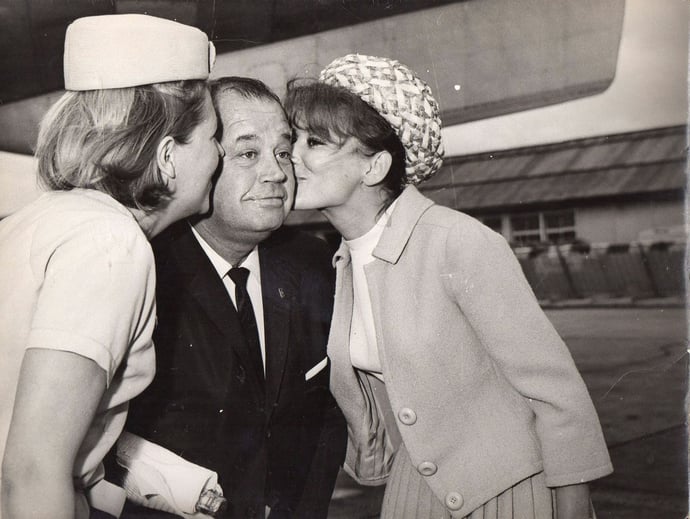
John Steele and Irina Demick, Orly airport, France
When he landed at Orly airport, France, in 1964, Irina Demick, the seductive French underground resistance actress of the film, embraced him in front of the photographers!
In Sainte-Mère-Eglise, he puffed out his chest on the church square, signed autographs, toasted with workers, sympathizeed with the mayor, Alexandre Renaud, and his wife, Simone, who were very involved in welcoming veterans and promoting their commune.
In the United States too, John Steele gained notoriety. It must be said that he had a special sense of humor, and that he was constantly wandering with a “call”, to imitate the call of the duck! On the evening of a great veterans meeting, he interrupted the speech of General James Gavin, venerable strategist of D-day. Andy Andersen, former president of the association of veterans of the 82nd Airborne Division remembers: "We were all there to listen to Gavin when all the sudden we heard” "quack quack". It’s “Big Ass John,” impatient to have a drink! Everybody bursts out laughing, starting with the general, who throws at him: “I’m almost done, Steele!” Two minutes later, “quack quack," the veterans burst out again with laughter!
Steele then moveed out to Wilmington, an affluent city in North Carolina. Verma, his nursing companion, had a daughter of about thirty, Doris, born from a first marriage who did not really have the best relations with her father-in-law. She did, though, realize how much his military past had marked him. His associative activities with the veterans took a lot of his time: he was at all the conventions, at all the ceremonies, and with extreme care preserved everything which related to "his" war - photos, articles, letters... As for his decorations, about twenty in total, they were put under glass in a wooden frame he built himself. "He used his garage as his place of memory," said Doris. "It was a very masculine den, with a star-shaped banner, a parachute hanging from the ceiling, a fridge full of beer."
But Steele suffered from serious health problems. As of 1961, a cancer of the throat forced him to undergo severe treatments, followed by a tracheotomy. The respiratory equipment which the doctors equipped him with gave his voice a cavernous tone, but did not dissuade him at all from drinking whiskey or smoking!
In May, 1969, at the Fayetteville Veterans' Hospital, a cigarette in his hand, he told his story for the last time to the local newspaper, The Observer. Everything is there: the C-47, the wound, the bell tower ... "There was furious fighting around the church," he said, insisting that he had an "overview", a "bird view”.
In the following days, his stepdaughter came to his bedside. "I was wearing a red, white, blue dress, the colors of the flag," she said, "and when he saw me, he whistled at me like at a pretty girl. He died at the age of 56 the next morning at 5 am. With my mother and one of her sisters, we took him back to Metropolis." The saying was that he dreamed of being buried at Sainte-Mère-Eglise or Arlington cemetery… but we will never know, as he took his secrets to the grave. He was buried at the Masonic cemetery of Metropolis.
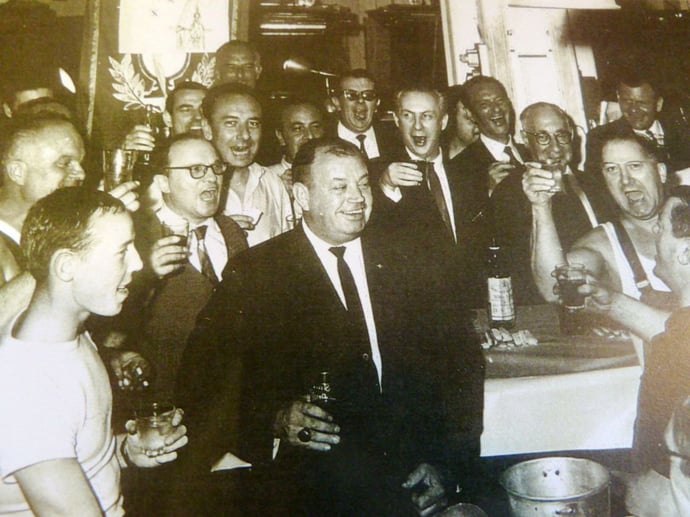
John Steele was a genuine nice guy enjoying life, here in Sainte-Mère-Eglise...!
So reading what you just read, you could ask yourself the following:
- Did he really say everything about that night in June 1944?
- Did he not force the line by pretending to have had a "bird's eye view" of the place?
Well, one has to recognize the fact that Steele had always overshadowed the fact that one other paratrooper, Kenneth Russell, fell on the church almost at the same time as he, and that a second one, John Ray, fell on the ground!
Why? Only Steele can answer that question… But let’s take a closer look together.
Who is Kenneth Russell? For decades, Kenneth Russell remained in the shadow, humbly leaving the ghost of John Steele monopolize the front-stage. Then, fate would change in 1988, during a veterans meeting of the 82nd Airborne Division. An American historian, Ronald J. Drez, gathered his testimony, confirmed by other veterans. With just one stroke, you will discover that his narrative brings a new, and to say the least a disturbing light to the sequence of the church…!
In June 1944, Russell was only 17 years old; he grew up in Maryville, Tennessee, and cheated on his age to join the army. (4)

Russell was one of the youngest aboard the C-47 transporting Steele and a dozen other paratroopers. As soon as he was dropped above Sainte-Mère, the teenager measured what hell awaits him. The antiaircraft batteries made a devil's whine sound, he saw Germans running, aiming, shooting, a farm was on fire ... Fortunately, his parachute dragged him toward the church. The shock was rough and he almost passed out, but he found the strength to regain control. His gear was caught in a kind of gargoyle, 6 meters from the ground. Above him, he noticed another paratrooper suspended, unidentified, whose body seemed inanimate.
While Russell was trying to seize his knife to free himself, a 3rd paratrooper from Company F, Sergeant John Ray, landed at his feet, so to speak. Before he had time to straighten up, a German approached and shot him. Hit in the stomach, the sergeant collapsed. Thinking him dead, the German immediately pointed his weapon to the two Americans, John Steele and Kenneth Russell, hanging from the sculptures of the building. Russell expected to die without even having touched the French soil. But Sergeant John Ray, in a final burst of life, managed to kneel and take out his Colt 45 to kill the German with a bullet in the neck! Russell finally managed to cut the ties of his parachute, tumbled down the church, crawled up to the sergeant. Sadly it was too late; there was nothing more to do for the 21 year old newlywed. Russell glanced toward the roof, where the other paratrooper still gave no sign of life, and thus set off to find a hideout.
So, yes, there was a 2nd soldier (Kenneth Russell) hanging at the bottom of the belfry, and a 3rd (John Ray), on the ground, who saved both of them in extremis.
Why did John Steele not talk to his relatives or to Cornelius Ryan about them?
In his two reference interviews, one collected at the end of the film, the other at the hospital before passing away, he never mentioned them...
If Russell's account is true - and everything indicates it is - the hero of Metropolis could not have ignored their presence, even when he was playing dead, eyes half closed. At the worst, he was surely informed afterwards or after the war, thru discussions with his comrades.
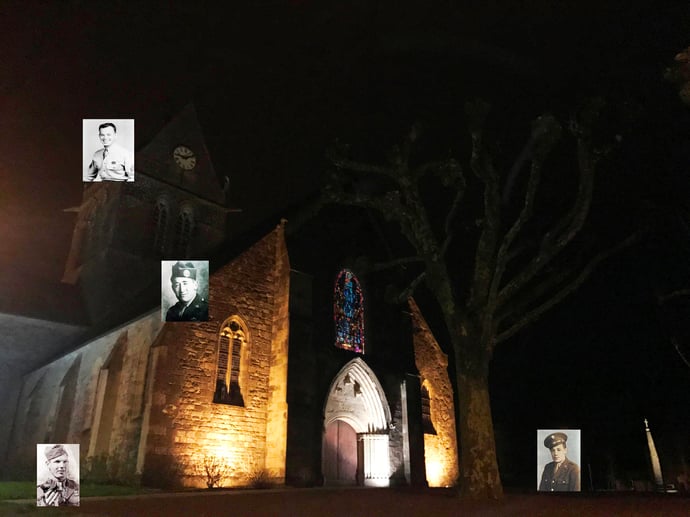
John Ray lands on the ground (left) KIA June 6, 1944
Kenneth Russell lands on the roof top (left)
John Steele hangs from the church Steeple (left)
Ladislav Tlapa lands in a tree KIA June 6, 1944
Kenneth Russell died of pneumonia on the night of June 5-6, 2004, sixty years after D-Day. For years he had a correspondence with Robert Tlapa, the cousin of Private Ladislav Tlapa, one of the members of company F who died on a tree of the Sainte-Mère-Eglise square. In an unpublished letter, Russell was astonished, with a bitter irony that "almost all the surviving paratroopers" claimed to have jumped into the heart of the village. In reality, they were not so many, not more than twenty. "According to Russell, there was a sort of code of honor between the veterans," recalls Robert Tlapa, "a rule that you should not contradict a comrade-in-arms even when he distorts the truth a little."
In fact, in the United States, no one criticized Steele for his "blackout". Russell himself was never jealous of his fame,; on the contrary, he appreciated it, according to his son, Gerald. Historian Ronald Drez confirms: "Ken just said to me,' Maybe John, like many people, did not want to share the spotlight? He did not care if we did not talk about him.'"
Not mentioning John Ray bothered him more, or at least that’s my belief, and probably the reason why he finally ended his silence to recognize Ray's sacrifice while saving the life of his two comrades.
Sergeant John Ray is buried with his comrades at the Normandy American Cemetery of Colleville-sur-Mer (Omaha beach).
In 2002, Russell traveled to Sainte-Mère-Eglise, with Ronald Drez and Sergeant Ray's widow. On the steeple of the church, they saw the false paratrooper hanging on the wrong side… tourists taking pictures, not aware of it!
The longest day of Sainte-Mère-Eglise continues on in time!
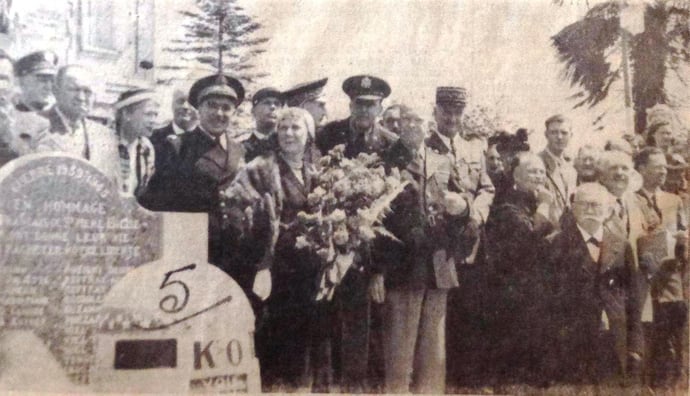
General Eisenhower and his wife, 6 June 1951
(1) General Eisenhower was to return to the Cotentin in 1951 while being in Paris as the head of NATO. The previous year, in October, as Rector of Columbia University, during a speech in Charleston at a meeting of alumni, he stated that he was ready to accept the command of a united army of the United States for the North Atlantic: "I am a soldier and I will do what I am ordered to do". November 8th he announced that he would soon return to Europe as the commander of the Western European Defense Forces and on the 19th of December he was officially appointed to this post. He arrived in Paris on January 8th, 1951, to make a tour of inspection of the various Atlantic Alliance countries before returning to Washington on the 31st. On February 21, he was back to take his post of command. He had traveled aboard the Queen Elizabeth and disembarked at Cherbourg. At the ferry terminal, Ike was welcomed by different local personalities such as but not limited to Mr. Edouard Le Bas, prefect of the Manche department; the Admiral Bathes, Maritime prefect; Mr. Cornat, senator-mayor of Valognes; Mr. Schmitt and Mr. Guilbert, deputies of the Manche department. A few months later, invited to preside the annual ceremonies commemorating D-Day, General Eisenhower visited Normandy on June 6, 1951. After spending the morning in Bayeux, he took off from Caen-Carpiquet airport and flew over the landing beaches. Accompanied by his wife, he landed at the airfield of Maupertus around 12:15 to be welcomed by the prefect of the Manche department and legion of personalities from the region.
The General, recognizing, while passing thru the crowd of personalities some who had welcomed him five months earlier upon his arrival at Cherbourg, greeted them amiably. This commemorative celebration of the 7th anniversary of the landing was to have exceptional brilliance and seven folk groups from different regions of France participated (including the Alfred Rossel Company of Cherbourg). After the reception of the personalities by the local authorities - and during which a beautiful wreath of flowers was offered to Mrs. Eisenhower - the procession formed to reach the Borne 0 of the Freedom Road to Bastogne’s in front of the town hall. On the way, the children of the schools threw flowers, shouting: “Long lives Eisenhower”. On each side of the monument were lined up young boys of the locality dressed as American paratroopers.
Ike squeezed their hands, telling each one a friendly word. It was at this moment that General Eisenhower's picture was taken, greeting the young Yvon Castel, then 11 years old, son of Mr. and Mrs. Castel, novelty merchants, and near whom you can recognize Maurice Renaud, son of Mr. and Mrs. Alexandre Renaud.
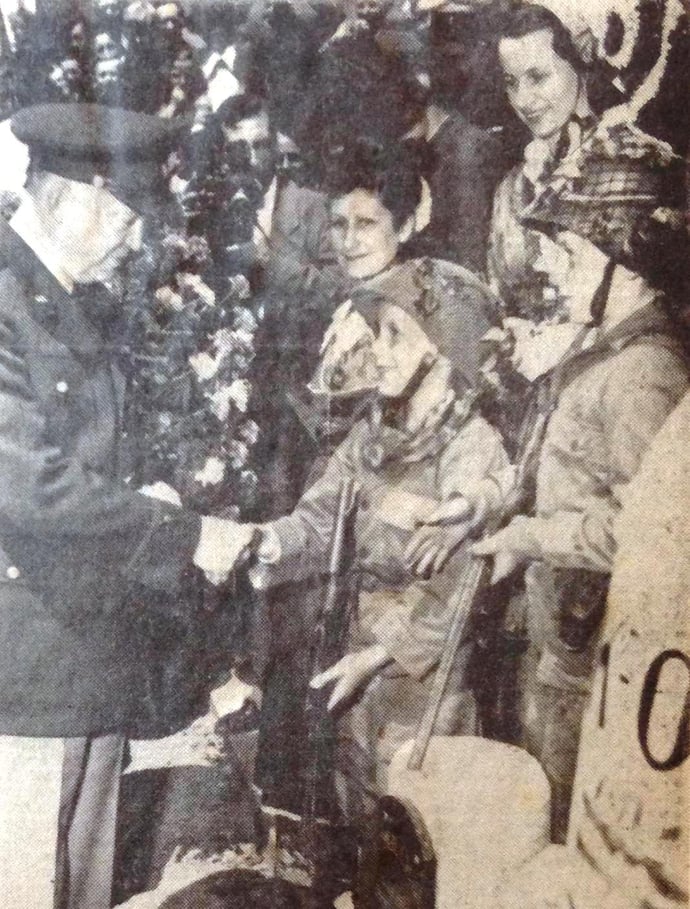 Yvon Castel shaking the hand of General Eisenhower, June 6, 1951
Yvon Castel shaking the hand of General Eisenhower, June 6, 1951
Later, when General Eisenhower became President of the United States, Yvon Castel sent him a copy of this photograph for him to sign. Sometime later he received the signed photo with a letter from the White House, signed by Miss Ann C. Whitnin, secretary of the President. Then, on the esplanade, Mr. Philippe, the mayor, read out the decision of the Municipal Council of Sainte-Mère-Eglise deciding unanimously to appoint General Eisenhower as Honorary Citizen of the city, awarding him with a citizenship Parchment. Mr. Renaud, former mayor of Sainte-Mère-Eglise during WWII, who the previous day had been awarded the Liberation Medal to recognize his glorious services, spoke in English. After welcoming General Eisenhower and briefly recalling the events of 1944, stated he was pleased to see the liberator of the city "returning among us in Peace" and to whom "Normandy and all the French provinces gathered here address their grateful salvation".
He then handed the general a Norman tin pitcher, containing, enveloped in a piece of embroidered parachute, a little bit of earth coming from the American cemetery. General Eisenhower then spoke: "It is a great privilege for me to return today to Sainte-Mère-Eglise, the first city in France liberated by the allies. Been honored as a citizen of honor in the city, I will keep it with fond memories throughout my life. It is our hope and our prayer that the people of this city will never hear a gun again. We believe that during the last war we have taught all aggressors whoever they are that the soil of France is really a sacred soil. The culture, the people and the soil of France are sacred for all men. The whole world would come together to defend them." After signing the Guest Book of Sainte-Mère-Eglise, the general, amid applause, was presented to the different folk groups showing a high interest in the beauty and variety of the regional costumes. Then he went back to Bayeux to continue his pilgrimage of the landing places. The Freedom Road from Sainte-Mère-Eglise, Utah beach and Cherbourg to Bastogne had been inaugurated 3 years earlier, and now in front of Borne 0 - not to be confused with Borne 00 of Utah beach - General Eisenhower could not forget what he had stated previously: "All those who follow the path of freedom must feel themselves penetrated by the spirit of camaraderie and solidarity which animated the soldiers of the Allied forces who fought along this road in 1944 The same unity is still necessary if we are to maintain respect for human dignity and freedom in the world and ensure peace for present and future generations.”
(2) Rudolf May and Rudi Escher were in the steeple of the church. Corporal Rudolph May in June 1944 had under his order ten men as observers, first stationed in Montebourg, then in Sainte-Mere-Eglise. He stated in an interview 40 years after Dday the following: "Everything was quiet that night, so much so that we were having fun racing each other with bicycles around the church square ... At 11 pm I took my post in the bell tower, next to the telephone box. Shortly before midnight, some aircraft flew over Sainte-Mère-Eglise. I was seeing "things" falling off the planes. I warned my chiefs of it who told me to stay on watch. As time went on, the number of planes increased. The planes were dropping objects that looked like shells. In reality, they were containers...
Now planes were coming by waves with hundreds of paratroopers jumping out. I could see them come down thanks to a house burning on the other side of the square (where the museum is situated today). They fell on the roofs, in the streets, and even in the trees. In the bell tower, one of my men had just been killed by a bullet. Suddenly everything turned black around us. Through the openings of the belfry, I saw something moving. A paratrooper had fallen on the steeple itself, and remained hanging by the lines of his parachute. He seemed dead. Then after a while, I heard his voice... My comrade wanted to shoot him. “Are you crazy?" I said. “If you shoot him, we'll be dead meat for the others”. I had a pocket knife on me, not very sharp. Yet I managed to cut the lines of his parachute, and said to myself that the paratrooper won’t be a danger for us as it will be impossible for him to climb back up in the steeple. Later on during the battle, given the events, we wanted to run away... Some of our officers realizing what we were trying to do shot us ... I was wounded on the shoulder then taken as a prisoner. I was cared for by an American doctor then transferred to the coastline to a POW camp. I can still se













